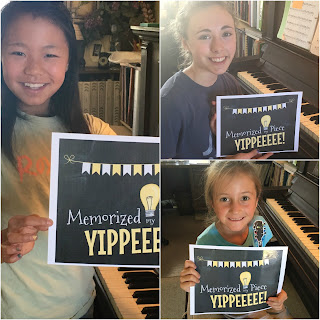It's the end of the school year 'crunch time.' I'm wrapping up my lesson plans for the month and heading into a recital with my piano students soon. My goal is for the students to have some performance experience. You never know when you're going to inspire someone with your piano playing. I think it's all about encouraging one another. Needless to say, students don't have to memorize their recital songs but many of them have. Probably, around 8 chose to play without sheet music. So great!
Well, a long time ago, a very talented musician named Anthony Gray encouraged me with some chord patterns and they have helped me a lot. One is just improvising in C and playing this pattern:
L.H. / R.H.
CG/C = C Chord
CG/Em = CM7(add9)
CG/ Am = C6
CG/Bb = C9(sus4)
CG/G = CM7(add9)
CA/G = C 6/9
So, try it and I think you'll like it. Then, do it in all keys. Here's another tip that Anthony shared with us...
Using both hands, choose C with your left-hand pinkie (#5), then play G with your pointer finger, and play C with your thumb (#1). So, CGC and then right-hand thumb plays E-G-C. You will notice a pattern on the left hand (you have an octave with a 5th). On the right hand, you have skipped one white key, played G, then skipped 2 white keys and played C. Press all the keys down at the same time to memorize this pattern. You can start on any white key and use this pattern. These notes sound good together in any way you want to play them. One at a time, or two at a time...
Here's another song I learned from Anthony:
L.H. / R.H.
Ab/DbFAb You
Bb/EbGBb are
C/EbAbC great
Eb/GBbEb and
Db/FAbDb awe-
C/EbAbC some
Bb/EbGBb God
Bb/EbGBb For
C/EbAbC ev-
Db/FAbDb er
Eb/GBbEb faith-
Eb/GBbEb ful
Db/FAbDb right-
C/EbFAbC eous
Bb/EbGBb king
Db/FAbDb your
C/EbAbC name
Bb/EbGBb be
Ab/DbFAb prais
Ab/CEbAb ed
Ab/CEbAb your
G/BbEbG name
F/AbDbF be
Eb/GBbEb praised
There's a lesson on Seventh Chords that was popular a while back and it sure helped a lot. If you remember that a 3-toned chord is called a 'Triad'... Then, you may recall a 4th-toned chord is called a 'Seventh'.
A seventh (or dominant) chord is built similar to a major triad. In fact, a seventh chord is a major chord with an added 'minor third" interval on top. Remember that a major triad is:
major third + perfect fifth
major third = 4 half steps or two whole steps
minor third = 3 half steps or 1 1/2 whole steps
Seventh chord = major third + perfect fifth + minor third
So, a C major chord is CEG. To create a C Seventh Chord (C7), simply add a minor third on top of the G. From G to Ab is 1 half step. From G to A is 2 half steps and from G to Bb is 3 half steps.
3 half steps = "Minor Third interval. So, by adding a Bb to a C major chord, you have now created a C7 chord.
C7 = C + E + G + Bb
Try playing this chord in all 12 keys! ( C7, D7, E7...)
This chord is one of the most utilized chords in gospel music. the added minor third creates the "blues" feeling used in gospel hymns, blues rhythm & blues, rock and so on.
You may be interested in Chords 101 & 102
"The beautiful thing about learning is that no one can take it away from you." B.B.King












![Validate my Atom 1.0 feed [Valid Atom 1.0]](valid-atom.png)







